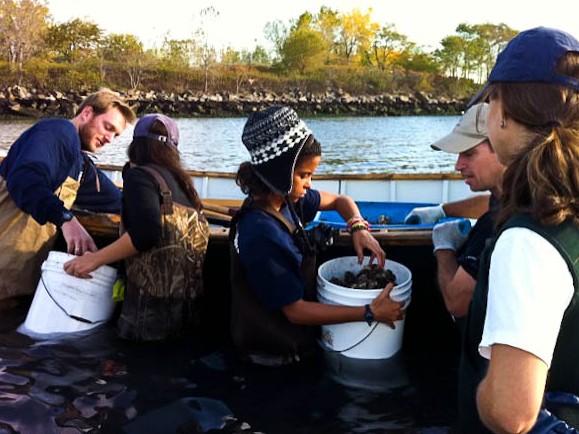NEW YORK—New York Harbor School, the city’s first maritime high school in over 15 years, is looking to take environmental stewardship past recycling and composting. By actively engaging its high school students in a large-scale oyster restoration project, the school hopes to not just clean up the waterways surrounding New York, but restore it to the bountiful ecosystem it once was.
“There used to be 260,000 acres of oysters in this estuary system,” New York Harbor School co-founder Murray Fisher said during a tour of the school on Tuesday.
New York’s waterways used to teem with fish and other marine life not seen today, with oyster beds being one of the largest navigational hazards.
“New Yorkers cannot even comprehend that was the ecosystem,” Fisher said.
Pollution killed off almost all of the oysters leaving the harbor with miles of flat mud underwater.
Fisher created the school with the hopes of incorporating the oyster into a long-term restoration program.
“Nature has designed something so perfect for all of our water-related water quality related problems,” he said.
New York Harbor School was landlocked in Bushwick, Brooklyn, for its first seven years making it difficult to work on the project. Students had to travel 45 minutes by train to work on the project. A move to Governor’s Island in 2010 opened up opportunities that Fisher never knew were possible.
New state-of-the-art equipment and closer proximity to the water has allowed for a substantial increase in the number of oysters the students grow and maintain.
Instructor Pete Malinowski designed and built a floating upwelling system, called a FLUPSY, to house 100,000 oysters. It is the first of its kind in New York Harbor. The students have grown the system to 500,000 oysters and hope to increase their output this year.
The school’s six maritime specific programs all work together to grow the project with the aquaculture class taking the lead in oyster restoration.
While the technical curriculum at New York Harbor School is unique, it is still a public high school. Every school year, 125 students are randomly selected for the school by a lottery. Some students who enter the program are eager to participate while others, like 17-year-old senior Alimot Yusuff just end up there.
Yusuff came in with a love of science, but no desire for any environmental work. Her tone soon changed and she fell in love with the oyster restoration program. She cited it as a main reason for her staying engaged in her studies.
“This project has shaped me as a student. It has made me more than just a student. It has turned me into an environmentalist,” she said while walking on campus.
Yusuff will attend St. Lawrence University in the fall where she hopes to study more environmental science.
Substantial Growth
New York Harbor School, which started with only a few hundred oysters, is now starting to see substantial growth. Oysters raised in the hatchery in the classrooms are moved into the FLUPSY dock where they stay for six months. When the oysters are large enough they are moved to one of five reefs around New York: Governor’s Island, Staten Island, Soundview, Bay Ridge Flats, and Hastings.
The school’s impact is enough to get multiple local, state, and federal agencies involved, something Tiffany Smythe, the newly hired director of harbor restoration and policy, has been tapped with coordinating.
“We have really ambitious goals and a lot of what we are trying to do has simply never been done before at this institution and in New York Harbor,” Smythe said. “So we are paving the way in terms of a new way for teachers to work with each other and work on applied projects.”
The goals of New York Harbor School are lofty, but if they are successful, high school students will be responsible for having what could be one of the biggest positive ecological impacts in New York Harbor.
Principal Dudley believes continuing to increase the amount of oysters in the harbor over the next 20 years, “will filter the harbor every three days and this harbor will be a lot cleaner than it is already.” He added, “Hopefully we can leave a legacy and the students can leave a legacy for their children of a cleaner harbor.”











